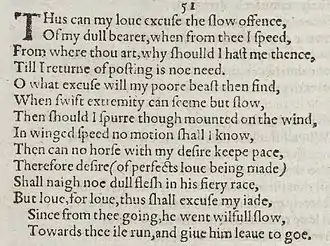Sonnet 51
Sonnet 51 is one of 154 sonnets written by the English playwright and poet William Shakespeare. It is part of the Fair Youth sequence, in which the poet expresses his love towards a young man. It is a continuation of the argument from Sonnet 50.
| Sonnet 51 | |||||||
|---|---|---|---|---|---|---|---|
 Sonnet 51 in the 1609 Quarto | |||||||
| |||||||
According to the Norton Anthology, sonnet 51 is considered part of the "long sequence" (18-126) and focuses on the young man who Shakespeare wrote about in the preceding group of sonnets namely the first 17 sonnets known as the procreation sonnets. This poem focuses on a young man fighting time to return to his lover, and includes description of haste and timeliness.
Structure
Sonnet 51 is an English or Shakespearean sonnet. An English sonnet contains three quatrains, followed by a final rhyming couplet. It follows the form's typical rhyme scheme, ABAB CDCD EFEF GG, and is composed in a type of poetic metre called iambic pentameter based on five pairs of metrically weak/strong syllabic positions. The sixth line exemplifies a regular iambic pentameter:
× / × / × / × / × / When swift extremity can seem but slow? (51.6)
- / = ictus, a metrically strong syllabic position. × = nonictus.
The fifth line, while it may be scanned as a regular iambic pentameter, may also be scanned with two variations:
/ × × / × × / / × / O! what excuse will my poor beast then find, (51.5)
The first is an initial reversal, the second a rightward movement of the third ictus (resulting in a four-position figure, × × / /, sometimes referred to as a minor ionic). There are seven possible initial reversals in this sonnet (in lines one, four, five, seven, eight, thirteen, and fourteen), three possible mid-line reversals (in lines three, eleven, and twelve) and two possible minor ionics (moving the first ictus of line two, and the third ictus of line five). This metrical agitation contrasts with the plodding regularity of Sonnet 50.
Notes
- Pooler, C[harles] Knox, ed. (1918). The Works of Shakespeare: Sonnets. The Arden Shakespeare [1st series]. London: Methuen & Company. OCLC 4770201.
References
- First edition and facsimile
- Shakespeare, William (1609). Shake-speares Sonnets: Never Before Imprinted. London: Thomas Thorpe.
- Lee, Sidney, ed. (1905). Shakespeares Sonnets: Being a reproduction in facsimile of the first edition. Oxford: Clarendon Press. OCLC 458829162.
- Variorum editions
- Alden, Raymond Macdonald, ed. (1916). The Sonnets of Shakespeare. Boston: Houghton Mifflin Company. OCLC 234756.
- Rollins, Hyder Edward, ed. (1944). A New Variorum Edition of Shakespeare: The Sonnets [2 Volumes]. Philadelphia: J. B. Lippincott & Co. OCLC 6028485.
- Modern critical editions
- Atkins, Carl D., ed. (2007). Shakespeare's Sonnets: With Three Hundred Years of Commentary. Madison: Fairleigh Dickinson University Press. ISBN 978-0-8386-4163-7. OCLC 86090499.
- Booth, Stephen, ed. (2000) [1st ed. 1977]. Shakespeare's Sonnets (Rev. ed.). New Haven: Yale Nota Bene. ISBN 0-300-01959-9. OCLC 2968040.
- Burrow, Colin, ed. (2002). The Complete Sonnets and Poems. The Oxford Shakespeare. Oxford: Oxford University Press. ISBN 978-0192819338. OCLC 48532938.
- Duncan-Jones, Katherine, ed. (2010) [1st ed. 1997]. Shakespeare's Sonnets. The Arden Shakespeare, Third Series (Rev. ed.). London: Bloomsbury. ISBN 978-1-4080-1797-5. OCLC 755065951.
- Evans, G. Blakemore, ed. (1996). The Sonnets. The New Cambridge Shakespeare. Cambridge: Cambridge University Press. ISBN 978-0521294034. OCLC 32272082.
- Kerrigan, John, ed. (1995) [1st ed. 1986]. The Sonnets ; and, A Lover's Complaint. New Penguin Shakespeare (Rev. ed.). Penguin Books. ISBN 0-14-070732-8. OCLC 15018446.
- Mowat, Barbara A.; Werstine, Paul, eds. (2006). Shakespeare's Sonnets & Poems. Folger Shakespeare Library. New York: Washington Square Press. ISBN 978-0743273282. OCLC 64594469.
- Orgel, Stephen, ed. (2001). The Sonnets. The Pelican Shakespeare (Rev. ed.). New York: Penguin Books. ISBN 978-0140714531. OCLC 46683809.
- Vendler, Helen, ed. (1997). The Art of Shakespeare's Sonnets. Cambridge, MA: The Belknap Press of Harvard University Press. ISBN 0-674-63712-7. OCLC 36806589.
.png.webp)
